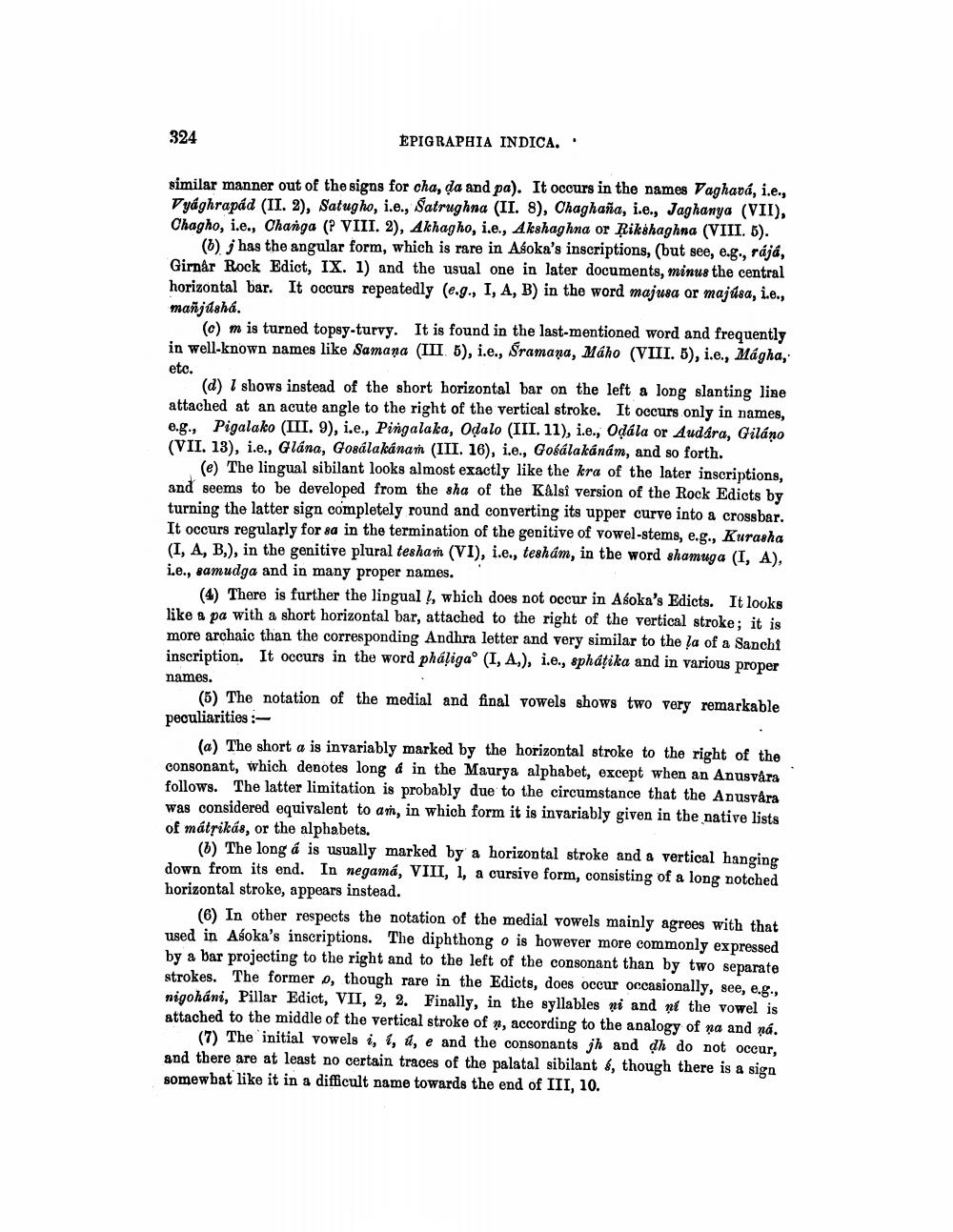________________
324
EPIGRAPHIA INDICA..
similar manner out of the signs for cha, da and pa). It occurs in the names Vaghavá, i.e., Vyághrapád (II. 2), Satugho, i.e., Satrughna (II. 8), Chaghaña, i.e., Jaghanya (VII), Chagho, i.e., Changa (P VIII. 2), Akhagho, i.e., Akshaghna or Rikshaghna (VIII. 5).
(6) j has the angular form, which is rare in Asoka's inscriptions, (but see, e.g., rájá, Girnår Rock Edict, IX. 1) and the usual one in later documents, minus the central horizontal bar. It occurs repeatedly (e.g., I, A, B) in the word majusa or majúsa, i.e., mañjúshá.
(c) m is turned topsy-turvy. It is found in the last-mentioned word and frequently in well-known names like Samana (III 5), i.e., Sramana, Maho (VIII. 5), i.e., Mágha, etc.
(d) 1 shows instead of the short horizontal bar on the left a long slanting line attached at an acute angle to the right of the vertical stroke. It occurs only in names, e.g., Pigalako (III. 9), i.e., Pingalaka, Odalo (III. 11), i.e., Odála or Audara, Giláno (VII. 13), i.e., Glána, Gosálakánam (III. 16), i.e., Gokálakánám, and so forth.
(e) The lingual sibilant looks almost exactly like the kra of the later inscriptions, and seems to be developed from the sha of the Kalsi version of the Rock Edicts by turning the latter sign completely round and converting its upper curve into a crossbar. It occurs regularly for sa in the termination of the genitive of vowel-stems, e.g., Kurasha (I, A, B,), in the genitive plural tesham (VI), i.e., teshám, in the word shamuga (I, A), i.e., samudga and in many proper names.
(4) There is further the lingual Į, which does not occur in Aboka's Edicts. It looks like a pa with a short horizontal bar, attached to the right of the vertical stroke; it is more archaic than the corresponding Andhra letter and very similar to the la of a Sanchi inscription. It occurs in the word pháļigao (I, A,), i.e., sphátika and in various proper names.
(5) The notation of the medial and final vowels shows two very remarkable peculiarities -
(a) The short a is invariably marked by the horizontal stroke to the right of the consonant, which denotes long & in the Maurya alphabet, except when an Anusvåra follows. The latter limitation is probably due to the circumstance that the Anusvåra was considered equivalent to am, in which form it is invariably given in the native lists of mátrikás, or the alphabets.
(6) The long á is usually marked by a horizontal stroke and a vertical hanging down from its end. In negamá, VIII, I, a cursive form, consisting of a long notched horizontal stroke, appears instead.
(6) In other respects the notation of the medial vowels mainly agrees with that used in Asoka's inscriptions. The diphthong o is however more commonly expressed by a bar projecting to the right and to the left of the consonant than by two separate strokes. The former p, though rare in the Edicts, does occur occasionally, see, e.g., nigoháni, Pillar Edict, VII, 2, 2. Finally, in the syllables ni and ni the vowel is attached to the middle of the vertical stroke of , according to the analogy of na and ná.
(7) The initial vowels i, i, a, e and the consonants jh and dh do not occur, and there are at least no certain traces of the palatal sibilant 6, though there is a sign somewbat like it in a difficult name towards the end of III, 10.




